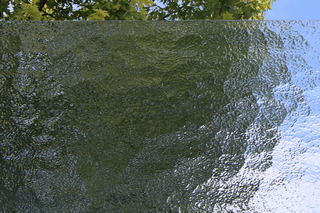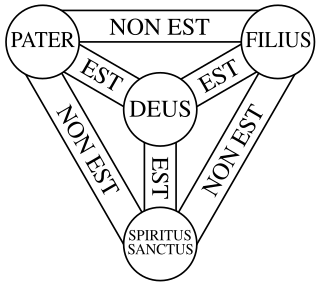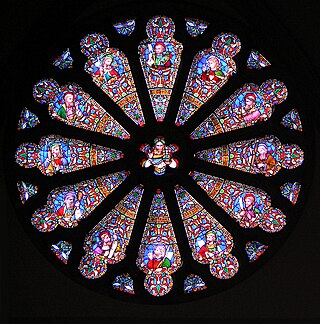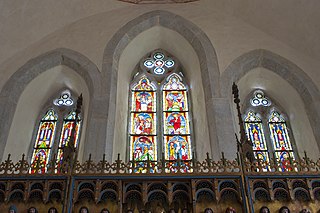Stained glass refers to both coloured glass as a material and to works made from it.
Stained glass refers to both coloured glass as a material and to works made from it.
Stained glass may refer to:
Stained glass may also refer to:
Capital and its variations may refer to:

Stained glass is coloured glass as a material or works created from it. Throughout its thousand-year history, the term has been applied almost exclusively to the windows of churches and other significant religious buildings. Although traditionally made in flat panels and used as windows, the creations of modern stained glass artists also include three-dimensional structures and sculpture. Modern vernacular usage has often extended the term "stained glass" to include domestic lead light and objets d'art created from foil glasswork exemplified in the famous lamps of Louis Comfort Tiffany.

Rose window is often used as a generic term applied to a circular window, but is especially used for those found in Gothic cathedrals and churches. The windows are divided into segments by stone mullions and tracery. The term rose window was not used before the 17th century and comes from the English flower name rose.

Cathedral glass is the name given commercially to monochromatic sheet glass. It is thin by comparison with 'slab glass', may be coloured, and is textured on one side. The name draws from the fact that windows of stained glass were a feature of medieval European cathedrals from the 10th century onward.

The Tree of Jesse is a depiction in art of the ancestors of Jesus Christ, shown in a branching tree which rises from Jesse of Bethlehem, the father of King David. It is the original use of the family tree as a schematic representation of a genealogy.

The Shield of the Trinity or Scutum Fidei is a traditional Christian visual symbol which expresses many aspects of the doctrine of the Trinity, summarizing the first part of the Athanasian Creed in a compact diagram. In late medieval Europe, this emblem was considered to be the heraldic arms of God.
A pyramid is a structure with triangular lateral surfaces converging to an apex.

Leadlights, leaded lights or leaded windows are decorative windows made of small sections of glass supported in lead cames. The technique of creating windows using glass and lead came to be known as came glasswork. The term 'leadlight' could be used to describe any window in which the glass is supported by lead, but traditionally, a distinction is made between stained glass windows and leadlights; the former is associated with the ornate coloured-glass windows of churches and similar buildings, while the latter is associated with the windows of vernacular architecture and defined by its simplicity.

A revival of the art and craft of stained-glass window manufacture took place in early 19th-century Britain, beginning with an armorial window created by Thomas Willement in 1811–12. The revival led to stained-glass windows becoming such a common and popular form of coloured pictorial representation that many thousands of people, most of whom would never commission or purchase a painting, contributed to the commission and purchase of stained-glass windows for their parish church.

Thomas Willement was an English stained glass artist, called "the father of Victorian stained glass", active from 1811 to 1865.

William Warrington, (1796–1869), was an English maker of stained glass windows. His firm, operating from 1832 to 1875, was one of the earliest of the English Medieval revival and served clients such as Norwich and Peterborough Cathedrals. Warrington was a historian of medieval glass and published an illustrated book The History of Stained Glass.

William Wailes (1808–1881) was the proprietor of one of England's largest and most prolific stained glass workshops.

Clayton and Bell was one of the most prolific and proficient British workshops of stained-glass windows during the latter half of the 19th century and early 20th century. The partners were John Richard Clayton (1827–1913) and Alfred Bell (1832–1895). The company was founded in 1855 and continued until 1993. Their windows are found throughout the United Kingdom, in the United States, Canada, Australia and New Zealand.

Munich-style stained glass was produced in the Royal Bavarian Stained Glass Manufactory, Munich, in the mid-19th century.

Medieval stained glass is the coloured and painted glass of medieval Europe from the 10th century to the 16th century. For much of this period stained glass windows were the major pictorial art form, particularly in northern France, Germany and England, where windows tended to be larger than in southern Europe. In some countries, such as Sweden and England, only a small number of original stained windows has survived to this day.

William Holland was a 19th-century British maker of stained glass and other decorative pieces. His work is represented in churches and stately homes across England, Wales, and Ireland. Holland of Warwick windows can be identified by his mark "Guil Holland Vaivic. Puix " written on a scroll in Latin in the lower right hand corner. Holland's stained glass reflects the influence of the Cambridge Camden Society and the Gothic Revival work of Thomas Willement. Willement revived in the early 19th century, the method used at York Minster to build the Great East Window in 1400 wherein coloured pieces are leaded and the lead then becomes part of the design, appearing as black lines in the window.
Reunion may refer to:

Enamelled glass or painted glass is glass which has been decorated with vitreous enamel and then fired to fuse the glasses. It can produce brilliant and long-lasting colours, and be translucent or opaque. Unlike most methods of decorating glass, it allows painting using several colours, and along with glass engraving, has historically been the main technique used to create the full range of image types on glass.

The surviving amount of medieval stained glass in Sweden is relatively small, compared to some other European countries. There are in total 165 medieval stained glass panes with figurative depictions surviving in 37 churches, constituting a total area of about 60 square metres (650 sq ft), a fragment of the original amount but still the largest amount found in any of the Nordic countries. Archaeological evidence and old drawings indicate that many more once existed.

English Gothic stained glass windows were an important feature of English Gothic architecture, which appeared between the late 12th and late 16th centuries. They evolved from narrow windows filled with a mosaic of deeply-coloured pieces of glass into gigantic windows that filled entire walls, with a full range of colours and more naturalistic figures. In later windows, the figures were often coloured with silver stain, enamel paints and flashed glass. Later windows used large areas of white glass, or grisaille, to bring more light into the interiors.